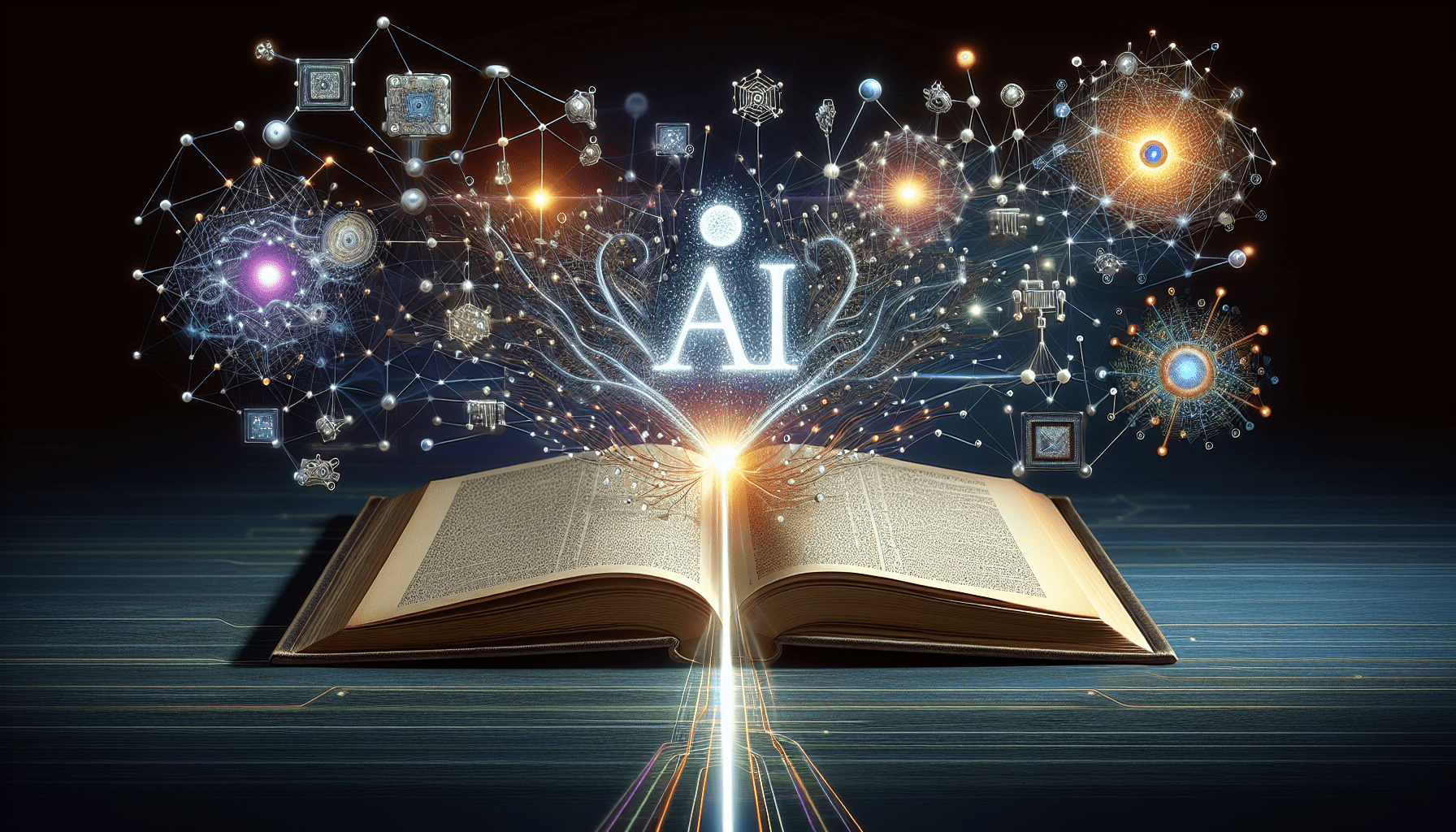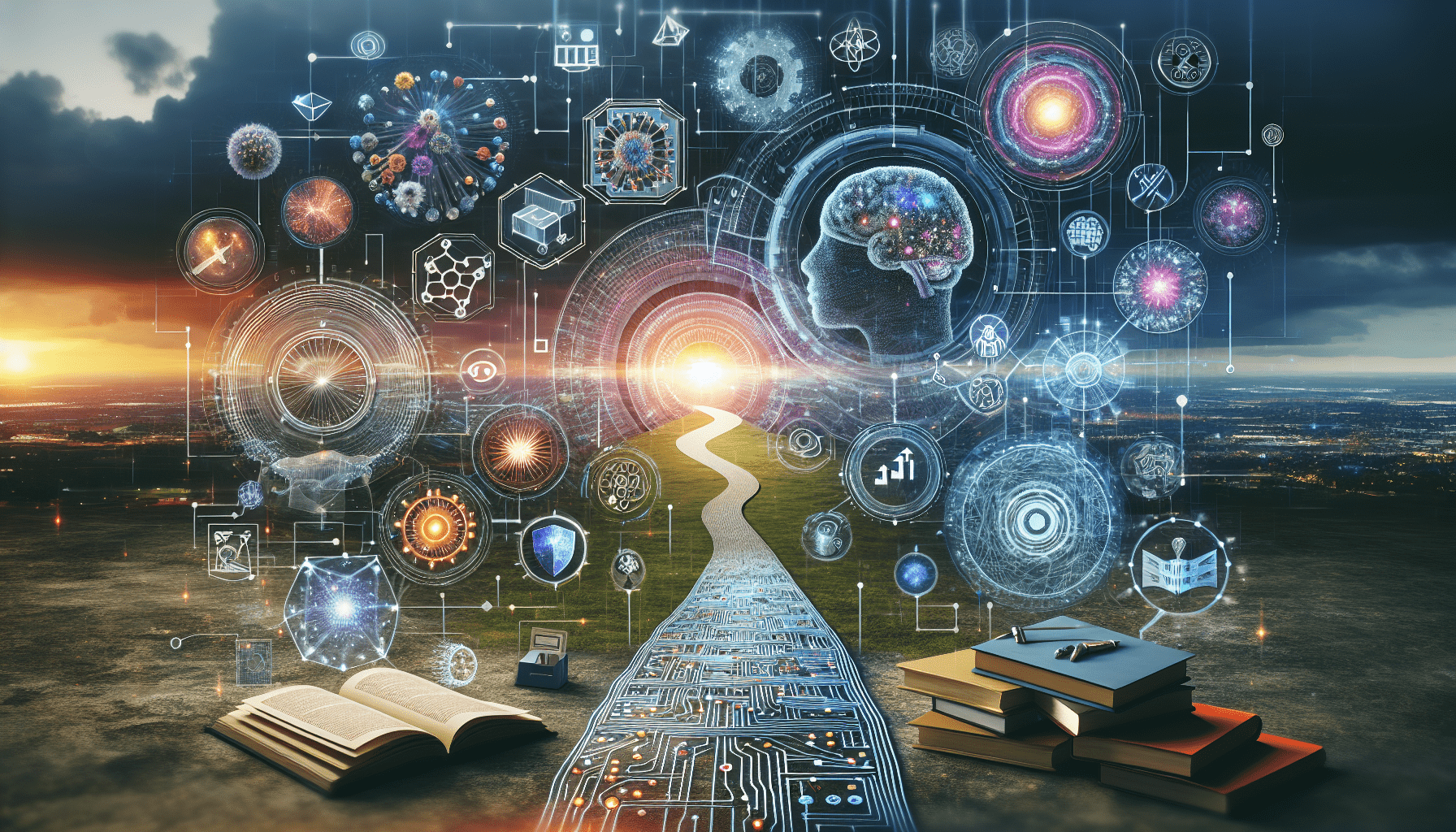Are you curious about delving into the world of artificial intelligence but unsure of where to start? Look no further! In this article, you will discover a step-by-step guide that makes learning AI a breeze. From understanding the fundamentals to practical applications, we break down the complex concepts into easy-to-follow steps. Whether you are a beginner or have some knowledge of AI, this article will provide you with the tools and resources to kickstart your AI learning journey. So, grab your notebook, put on your thinking cap, and let’s dive into the exciting world of AI in the most approachable way possible!
Understanding the Basics of AI
Artificial Intelligence (AI) is a rapidly advancing field that aims to create intelligent machines capable of performing tasks that typically require human intelligence. To delve into this exciting domain, it is essential to grasp the basics of AI. This article will walk you through the fundamental concepts and provide insights into different types of AI and their real-world applications.
Defining Artificial Intelligence
Artificial Intelligence refers to the development of machines or systems that can simulate human intelligence. It involves the creation of algorithms and models that enable machines to analyze data, reason, learn, and make decisions. AI is broadly categorized into two types: Narrow AI and General AI.
Narrow AI, also known as Weak AI, is designed to perform specific tasks, such as voice recognition or recommendation systems. On the other hand, General AI, also called Strong AI, aims to possess the same level of intelligence as humans, enabling machines to understand, learn, and perform any intellectual task.
Understanding the Types of AI
AI can be categorized into different types based on their capabilities and functionalities. Here are a few prominent types of AI:
-
Reactive AI: This type of AI operates solely in the present moment and does not have the ability to retain any memory or learn from past experiences. Examples include systems that play chess or diagnose diseases.
-
Limited Memory AI: Unlike reactive AI, limited memory AI possesses the ability to retain data for a short period. Self-driving cars often utilize this type of AI to store and process real-time sensor data.
-
Theory of Mind AI: This futuristic category of AI refers to machines with an understanding of human emotions, beliefs, and intentions. While this area is still in its nascent stage, it holds immense potential for the development of advanced AI systems.
-
Self-Aware AI: This type of AI reflects the concept of machines being aware of their existence and consciousness. At present, self-aware AI remains purely theoretical and has not been fully realized.
Exploring Real-World Applications
AI has found its way into various industries, revolutionizing the way we live and work. Here are some incredible real-world applications of AI:
-
Healthcare: AI is making significant contributions in the healthcare sector, assisting in disease diagnosis, drug discovery, personalized medicine, and robotics-assisted surgeries. It enables healthcare professionals to analyze large amounts of medical data quickly and accurately.
-
Finance: AI is being increasingly employed in the finance industry for fraud detection, algorithmic trading, credit scoring, and risk assessment. It can analyze vast quantities of financial data in real-time, thereby aiding in better decision-making.
-
Transportation: Self-driving cars are one of the most prominent applications of AI in the transportation industry. AI algorithms enable vehicles to navigate roads, make informed decisions, and enhance overall road safety.
-
Retail: AI-powered recommendation systems are widely used in the retail sector to provide personalized product recommendations to customers. This helps businesses improve customer satisfaction and increase sales.
-
Manufacturing: AI is transforming the manufacturing industry by automating processes, optimizing supply chain management, and predicting maintenance requirements. It improves efficiency, reduces costs, and enhances overall productivity.
By understanding the various applications of AI, you can see the immense potential it holds in shaping the future across multiple sectors. Now that you have a firm grasp of the basics of AI, let’s move on to building a strong foundation in mathematics – a crucial aspect of AI.
Building a Strong Foundation in Mathematics
Mathematics forms the backbone of AI, enabling us to develop algorithms and models to solve complex problems. To truly excel in AI, it is essential to have a solid understanding of key mathematical concepts. Let’s explore the areas of mathematics that play a vital role in AI.
Understanding Linear Algebra
Linear Algebra is a branch of mathematics that deals with the study of vectors, vector spaces, linear transformations, and matrices. It provides a framework to represent and manipulate data in AI. Concepts such as matrix operations, eigenvalues, and eigenvectors are foundational to many AI algorithms, including deep learning.
Mastering Linear Algebra will enable you to understand and implement various AI techniques effectively.
Mastering Probability and Statistics
Probability and Statistics are essential tools for understanding and working with data in AI. They help us make sense of uncertainty and provide a foundation for statistical methods used in AI algorithms.
Probability theory allows us to model and quantify uncertainty, while statistics enables us to analyze and draw meaningful conclusions from data. Techniques like Bayesian inference, hypothesis testing, and regression analysis are commonly used in AI applications. By mastering Probability and Statistics, you will be equipped with the necessary skills to analyze and interpret data effectively.

Exploring Calculus Concepts
Calculus is another crucial branch of mathematics for AI, providing tools to analyze and optimize mathematical models. Understanding concepts like differentiation and integration is vital for optimizing AI models, especially in deep learning and neural networks.
Calculus helps us determine how models can be adjusted to minimize error rates and improve performance. By exploring calculus concepts, you will gain insights into the mathematical foundation behind AI algorithms and their optimization processes.
Building a strong foundation in mathematics is essential for any aspiring AI practitioner. The next step in your journey is to learn programming languages suitable for AI development.
Learning Programming Languages for AI
Programming languages serve as the bridge between human intelligence and machine execution. In the field of AI, the choice of programming language is crucial as it determines the ease of development, availability of libraries, and overall efficiency. Let’s explore the programming languages commonly used in AI and their respective advantages.
Choosing the Right Programming Language
While there are several programming languages suitable for AI, the choice primarily depends on the specific AI tasks and the availability of libraries and frameworks. Some popular programming languages for AI include Python, R, Java, and C++.
When choosing a programming language, consider factors such as ease of use, community support, availability of libraries, and compatibility with AI frameworks.
Learning Python for AI
Python is widely regarded as the de-facto language for AI development. It boasts a simple syntax that is easy to read and write, making it ideal for beginners. Python’s extensive library ecosystem, such as NumPy, Pandas, and scikit-learn, provides powerful tools for data manipulation, analysis, and machine learning.
Python’s popularity in the AI community makes it an excellent choice for learning AI programming. Its versatility and ease of use make it suitable for a wide range of AI applications.
Exploring Other Popular Languages for AI
While Python is the go-to language for many AI developers, other languages also offer unique advantages. R, for example, is a statistical programming language widely used in data analysis and visualization. It provides excellent support for statistical modeling and specialized AI algorithms.
Java and C++ are popular choices for developing AI applications that require high performance and robustness. They offer strong support for object-oriented programming and are commonly used in implementing AI algorithms on resource-constrained systems.
While Python remains the most popular language for AI, exploring other languages can expand your toolkit and enhance your understanding of different programming paradigms.
Now that you have chosen a programming language, it’s time to dive into AI frameworks and libraries that simplify AI development.
Exploring AI Frameworks and Libraries
AI frameworks and libraries provide pre-built tools and functions that expedite AI development and implementation. They offer ready-to-use algorithms, models, and utilities, allowing developers to focus on building intelligent applications. Let’s explore some popular AI frameworks and libraries and their key features.
Understanding AI Frameworks
AI frameworks provide a complete set of tools and frameworks for building AI applications. They offer interfaces for constructing, training, and deploying machine learning models. These frameworks abstract away the complexities of AI development, enabling users to focus on the task at hand.
Frameworks like TensorFlow, PyTorch, and scikit-learn are widely used in the AI community due to their extensive functionality and community support.

Exploring TensorFlow
TensorFlow, developed by Google, is one of the most popular open-source AI frameworks. It provides a comprehensive ecosystem for developing and deploying machine learning models. TensorFlow supports various AI applications, including deep learning, reinforcement learning, and natural language processing.
The framework’s key features include a flexible architecture, distributed training capabilities, and a vast library of pre-built models. TensorFlow’s user-friendly interface and extensive documentation make it a preferred choice for many AI developers.
Utilizing PyTorch
PyTorch is another widely used AI framework known for its dynamic computational graph, which enables intuitive model creation and debugging. Developed by Facebook’s AI Research lab, PyTorch provides a seamless interface for building and training neural networks.
PyTorch’s simplicity and flexibility have made it popular in the deep learning community. It offers extensive support for GPU acceleration, distributed computing, and deployment on various platforms.
Exploring scikit-learn
scikit-learn is a versatile machine learning library for Python, built on top of NumPy, SciPy, and Matplotlib. It provides a comprehensive set of tools for data preprocessing, feature selection, model evaluation, and more. scikit-learn supports various machine learning algorithms, making it suitable for a wide range of AI tasks.
With an easy-to-use API and excellent documentation, scikit-learn is a valuable asset for beginners and experts alike.
By exploring AI frameworks and libraries, you can leverage pre-built functionalities and accelerate your AI development process. Now, let’s delve into machine learning algorithms – the essence of AI.
Understanding Machine Learning Algorithms
Machine Learning is a subset of AI that focuses on developing algorithms that enable machines to learn from data and improve their performance without being explicitly programmed. There are three main types of machine learning algorithms: supervised learning, unsupervised learning, and reinforcement learning.
Introduction to Machine Learning
Machine Learning algorithms learn from historical data to make accurate predictions or decisions. Instead of following explicit instructions, these algorithms identify patterns and relationships in data, enabling them to make informed decisions on new, unseen data.
Machine Learning tasks can be broadly categorized into regression, classification, and clustering, each requiring different algorithms and techniques.
Supervised Learning Algorithms
Supervised learning algorithms learn from labeled data, where the input samples are associated with known output labels. They aim to generalize patterns in the training data to predict correct outputs for unseen data.
Common supervised learning algorithms include linear regression, support vector machines (SVM), decision trees, and neural networks. These algorithms excel in tasks such as image recognition, sentiment analysis, and spam filtering.

Unsupervised Learning Algorithms
Unsupervised learning algorithms learn from unlabeled data, where the input samples do not have any associated output labels. These algorithms aim to discover underlying patterns, relationships, and structures in the data.
Clustering algorithms, such as K-means and hierarchical clustering, group similar data points together based on their characteristics. Dimensionality reduction techniques, like Principal Component Analysis (PCA) and t-SNE, help visualize and simplify complex datasets.
Reinforcement Learning Algorithms
Reinforcement Learning algorithms learn through interaction with an environment. They aim to maximize a reward signal by making a series of actions and observing the resulting outcomes.
These algorithms are commonly used in applications such as game-playing systems and autonomous agents. Reinforcement Learning utilizes concepts such as Markov Decision Processes (MDP), Q-learning, and policy optimization to learn optimal decision-making strategies.
Understanding the different types of machine learning algorithms will equip you with the knowledge to tackle a wide range of AI problems. Now, let’s explore the crucial aspect of working with data in AI – data preprocessing.
Working with Data for AI
Data is the foundation of AI, and working with data requires careful preprocessing to ensure its quality and compatibility with AI algorithms. Proper data preprocessing enhances the accuracy and effectiveness of machine learning models. Let’s delve into essential data preprocessing techniques in the context of AI.
Understanding Data Preprocessing
Data preprocessing involves cleaning, transforming, and organizing raw data to make it suitable for machine learning models. It is a crucial step as the quality of the input data directly impacts the model’s performance and accuracy.
Data preprocessing techniques include handling missing values, removing duplicates, handling outliers, and normalizing data. These techniques ensure that the data is in the right format and appropriate for input to AI algorithms.
Exploring Data Cleaning Techniques
Data cleaning focuses on identifying and correcting errors and inconsistencies in the dataset. Common data cleaning techniques involve handling missing values, dealing with noisy data, correcting inconsistent entries, and resolving duplicate records.
Through data cleaning, you ensure that the dataset is reliable and free from errors, allowing AI algorithms to make accurate predictions and decisions.
Feature Engineering
Feature engineering involves transforming raw data into meaningful features that can enhance the performance of machine learning models. It enables the extraction of valuable information from the dataset, which may not be readily apparent.
Feature engineering techniques include feature scaling, one-hot encoding, dimensionality reduction, and creating new features from existing ones. Proper feature engineering can significantly improve model accuracy and efficiency.

Handling Large Datasets
In the era of big data, handling large datasets is a common challenge faced by AI practitioners. Large datasets can be computationally expensive and cumbersome to work with. Therefore, effective techniques for data sampling, data separation, and distributed computing are essential.
Methods like random stratified sampling, cross-validation, and distributed computing frameworks like Apache Spark can help handle large datasets efficiently.
By mastering data preprocessing techniques, you can ensure the integrity and suitability of your data for AI algorithms. The next step is to train and test AI models using appropriate methodologies.
Training and Testing AI Models
Training and testing are crucial steps in AI model development. They allow us to evaluate model performance, identify areas for improvement, and fine-tune the model for optimal results. Let’s explore the essential techniques used in training and testing AI models.
Data Splitting and Cross-Validation
To effectively train and test AI models, the dataset is typically split into training, validation, and test sets. The training set is used to train the model, the validation set helps in model selection and hyperparameter tuning, and the test set evaluates the final model’s performance.
Cross-validation is a technique that allows for robust model evaluation by repeatedly resampling the dataset into different sets of training and validation data. It helps provide a more accurate estimate of the model’s performance on unseen data.
Training Supervised Learning Models
Training supervised learning models involves feeding the model with the training data and adjusting its parameters to minimize the error or maximize the likelihood of correct predictions. This process, often called optimization, aims to find the best set of model parameters that generalize well on unseen data.
Algorithms like gradient descent and backpropagation are commonly used in training neural networks, while algorithms like support vector machines and decision trees employ different optimization strategies.
Evaluating Model Performance
Evaluating the performance of an AI model is crucial to understand its capabilities and limitations. Common evaluation metrics for classification tasks include accuracy, precision, recall, and F1 score. For regression tasks, metrics like mean squared error (MSE) and root mean squared error (RMSE) are used.
Understanding evaluation metrics and choosing the appropriate metrics for a given task is key to assessing and comparing different models effectively.
Testing and Fine-tuning Models
Testing a trained AI model involves using the test set, which contains unseen data, to assess the model’s generalization performance. This step is crucial to ensure that the model performs well on new and unknown samples.
If the model performance is unsatisfactory, fine-tuning techniques such as hyperparameter tuning, regularization, and ensemble learning can be applied to improve the model’s performance.
By iteratively training, testing, and fine-tuning AI models, you can continuously improve their performance and adapt them to specific tasks and datasets. Let’s now explore an exciting area of AI – Deep Learning and Neural Networks.
Deep Learning and Neural Networks
Deep Learning, a subfield of machine learning, focuses on training artificial neural networks to learn and make predictions similar to the way the human brain processes information. Deep neural networks have revolutionized AI, achieving remarkable success in various fields. Let’s explore the essential concepts of deep learning and neural networks.

Introduction to Deep Learning
Deep Learning refers to the training of neural networks with multiple layers, allowing them to learn complex representations of data. Unlike traditional machine learning algorithms, deep learning models can automatically learn hierarchical patterns and structures from raw data.
Deep Learning has seen tremendous success in computer vision, natural language processing, and many other AI tasks, revolutionizing industries such as healthcare, finance, and autonomous systems.
Understanding Neural Networks
Neural networks are a computational model inspired by the structure and function of biological neural networks in the brain. They consist of interconnected nodes, called artificial neurons or units, organized into layers. Each neuron processes input data and produces an output signal, which is passed to the next layer.
Feedforward neural networks, convolutional neural networks (CNNs), and recurrent neural networks (RNNs) are popular types of neural networks used in deep learning.
Training Deep Neural Networks
Training deep neural networks involves feeding them with labeled data and adjusting their weights and biases to minimize the prediction error. This optimization process often relies on the backpropagation algorithm, which calculates the gradient of the model parameters with respect to the error.
Training deep neural networks can be challenging due to difficulties such as vanishing gradients, overfitting, and hyperparameter tuning. Advanced techniques like regularization, dropout, and adaptive learning rates help address these challenges.
Convolutional Neural Networks
Convolutional Neural Networks (CNNs) are a specialized type of neural network designed for processing grid-like data, such as images. CNNs have revolutionized computer vision tasks, achieving state-of-the-art results in image classification, object detection, and image generation.
CNN architectures leverage concepts like convolutional layers, pooling layers, and fully connected layers to learn hierarchical representations of visual data.
Recurrent Neural Networks
Recurrent Neural Networks (RNNs) are designed to handle sequential or time-series data, making them suitable for tasks like speech recognition, sentiment analysis, and natural language processing. Unlike feedforward neural networks, RNNs have feedback connections that enable them to capture temporal dependencies in data.
These networks employ recurrent connections and memory cells, allowing them to process and generate variable-length sequences of data efficiently.
By understanding the concepts of deep learning and neural networks, you can dive into the cutting-edge advancements in AI and explore their applications in various domains. Let’s now explore the fascinating field of Natural Language Processing (NLP) and its connection to AI.
Natural Language Processing and AI
Natural Language Processing (NLP) focuses on enabling machines to understand, interpret, and generate human language. It is a significant branch of AI that has revolutionized the way we interact with machines. Let’s explore the essential concepts and techniques in NLP.
Introduction to Natural Language Processing (NLP)
Natural Language Processing enables computers to communicate, understand, and process human language in a meaningful way. It encompasses tasks such as text classification, sentiment analysis, machine translation, and chatbots.
NLP techniques utilize machine learning algorithms, deep learning models, and linguistic rules to analyze and interpret textual data.
Managing Text Data for NLP
Text data in NLP requires careful preprocessing and cleaning, similar to the data preprocessing techniques discussed earlier. Textual data often contains noise, irrelevant information, and structural complexities that need to be handled before applying NLP techniques.
Techniques like tokenization, stop word removal, stemming, and lemmatization are commonly employed for text data management in NLP.
Building NLP Models
Building NLP models involves designing and training machine learning or deep learning models to solve specific language-related tasks. These tasks may include text classification, sentiment analysis, named entity recognition, and machine translation.
NLP models leverage algorithms like Bag-of-Words, Word Embeddings, Recurrent Neural Networks (RNNs), and Transformer models like BERT to achieve state-of-the-art performance in various language tasks.
Exploring Sentiment Analysis
Sentiment Analysis, a popular NLP task, aims to determine the sentiment or emotion conveyed in a piece of text. It can be used to analyze customer reviews, social media sentiment, and brand reputation.
Sentiment analysis models utilize techniques such as lexicon-based analysis, machine learning classifiers, and deep learning models to classify text as positive, negative, or neutral.
Text Generation
Text Generation is an exciting application of NLP that involves training models to generate coherent and contextually relevant text. Techniques like language modeling, recurrent neural networks, and transformer-based models allow machines to generate text that resembles human language.
Text generation finds applications in chatbots, automated content generation, and creative writing assistance.
Incorporating NLP techniques into AI allows machines to understand and interact with human language, enabling a range of applications from personalized chatbots to automated content generation.
Real-World AI Projects and Applications
AI has made significant strides in recent years, with numerous real-world projects showcasing its potential to revolutionize various industries. Let’s explore some exciting AI projects and applications that are transforming the world around us.
Building a Chatbot
Chatbots are AI-powered virtual assistants that can simulate human-like conversations. These intelligent agents find applications in customer support, information retrieval, and automated interactions. By utilizing natural language processing techniques and machine learning, chatbots can understand user queries and generate relevant responses.
Building a chatbot involves training models on conversational data, implementing dialogue management systems, and integrating the chatbot into various platforms.
Creating Image Classification Models
Image classification models utilize AI algorithms to categorize and label images based on their content. This technology is widely used in applications like autonomous driving, medical imaging, and content moderation.
Training image classification models involves feeding labeled samples to deep convolutional neural networks (CNNs) and fine-tuning their weights to recognize and classify objects accurately.
Recommendation Systems
Recommendation systems play a significant role in e-commerce, entertainment, and social media platforms. These systems employ collaborative filtering, content-based filtering, or hybrid approaches to personalize recommendations for users.
Recommendation systems leverage machine learning techniques to analyze user preferences, historical data, and social interactions to suggest relevant products, movies, or content.
Object Detection and Recognition
Object detection and recognition enable machines to identify and locate objects in images or videos. This technology finds applications in surveillance, autonomous vehicles, and augmented reality.
Object detection models, powered by deep learning algorithms like Faster R-CNN and YOLO, learn to detect and localize objects of interest within images or video frames accurately.
AI in Healthcare
AI has the potential to transform healthcare by improving diagnostics, drug discovery, personalized medicine, and patient care. Machine learning models can analyze medical images, predict disease outcomes, and identify patterns that aid in early detection.
AI algorithms can process vast amounts of patient data, contributing to more accurate diagnoses and personalized treatment plans.
Autonomous Vehicles
Autonomous vehicles or self-driving cars are a groundbreaking application of AI. These vehicles leverage a combination of sensors, machine learning models, and AI algorithms to navigate roads, recognize objects, and make informed driving decisions.
The development of autonomous vehicles involves training models on vast amounts of sensor data and simulating real-world driving scenarios to ensure safety and reliability.
These real-world AI projects and applications demonstrate the transformative power of AI in various industries. As AI continues to evolve, the possibilities for innovation and advancement are limitless.
In conclusion, learning AI the easy way involves understanding the basics of AI, building a strong foundation in mathematics, learning programming languages suitable for AI development, exploring AI frameworks and libraries, understanding machine learning algorithms, working with data, training and testing AI models, exploring deep learning and neural networks, delving into natural language processing, and exploring real-world AI projects and applications. By following these steps and continuously updating your knowledge in this rapidly evolving field, you can become proficient in AI and contribute to the exciting world of artificial intelligence.






Leave a Reply